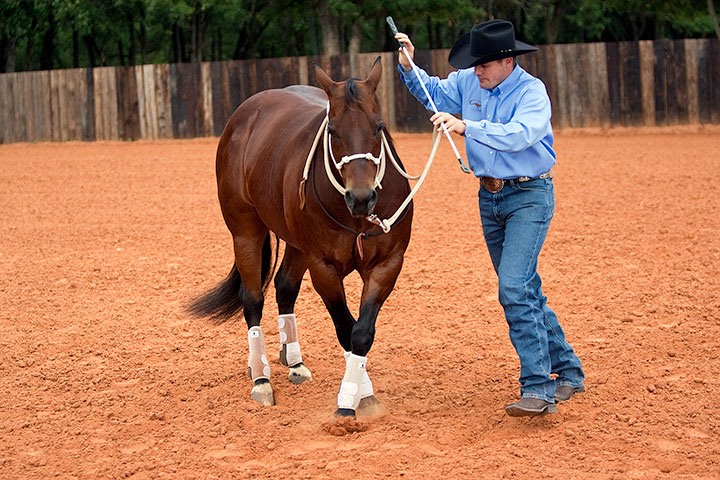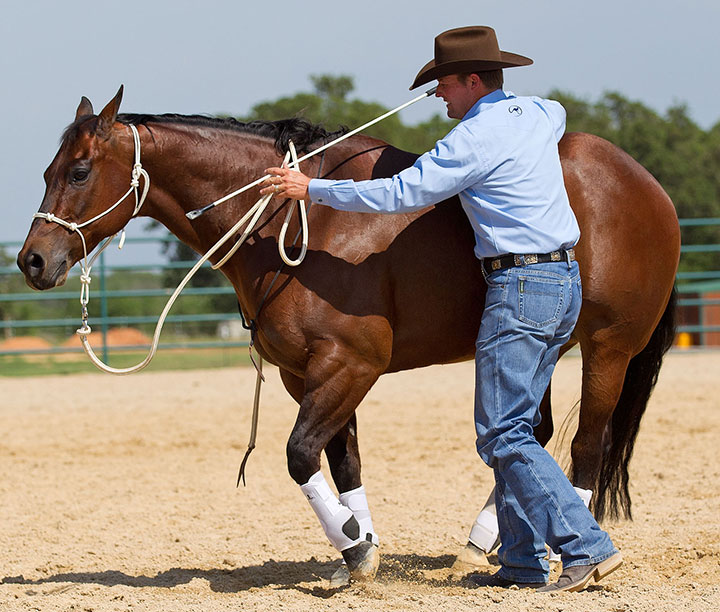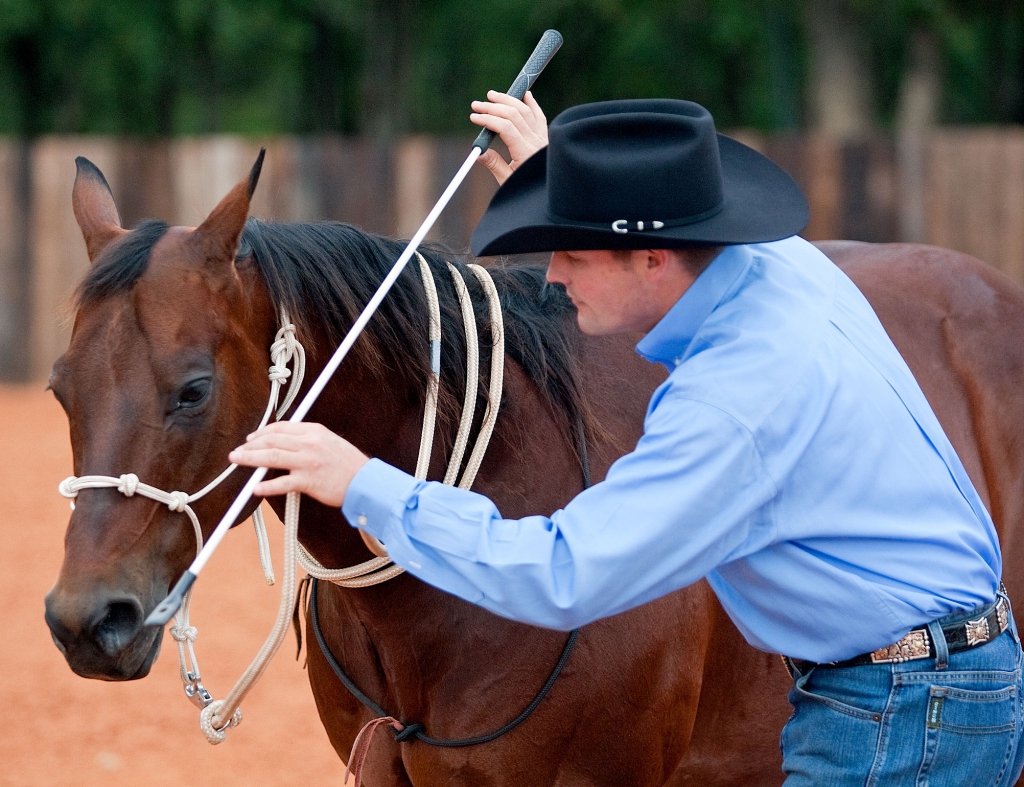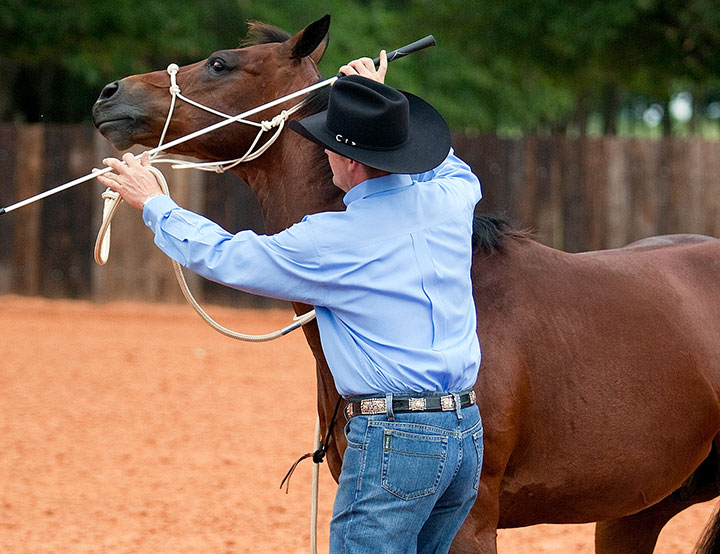Troubleshoot: Yield the Forequarters to Gain Your Horses Respect
When it comes to how well you’re able to control your horse’s body, there’s not a more telling exercise than Yield the Forequarters. There’s also no exercise that can be as frustrating to first teach a horse. Horses use their heads, necks and shoulders to push people around and move them out of their way. If you can move your horse’s forequarters, it’s a great sign that he is respectful. Horses seem to have an entirely different perspective of you when they know that you can move their front end.
Yield the Forequarters can be a difficult exercise to teach horses, especially those that have gotten away with pushing people around for years. Add a green handler that’s not sure how to teach the exercise to the situation, and it’s a recipe for frustration. Once you understand how to teach the exercise, it’s relatively easy. But in the beginning, it can be frustrating because most horses don’t want to help you.
The first step to curbing frustration is to educate yourself. Watch the DVD lesson from the Fundamentals Series and read the Arena Mates. If you don’t know what you’re doing, there’s no hope your horse will be able to figure it out either. If you find yourself running into trouble and can’t find the fix by referring to the Fundamentals Series, get hands-on help. Here are six scenarios that are likely to go wrong when you first teach a horse the exercise and fixes for each. Record yourself working on the exercise with your horse and then see if you’re committing one of these mistakes.
Scenario #1
What happens: The horse takes two good steps—he pivots on his hind foot and crosses his front legs over—and then the maneuver just falls apart. His energy drops, and, before you know it, rather than him pivoting and moving his front end away from you, his body is spinning like a coke bottle.
What went wrong: The likely culprit of this scenario is that you got greedy and asked the horse to take more steps than what he was ready for.
How to fix it: Take a step—or two!—back. The secret to great horsemanship is establishing a good starting point. If you find a small enough place to start, you can teach a horse just about anything. When teaching Yield the Forequarters, ask the horse for one correct step and then reward him. Practice asking him for just one step until every time you cue him to yield his forequarters, he gets it right. Then, ask him to take two steps. When he can take two steps correctly every time you ask, then ask for three steps. But if you can’t get one step, you won’t be able to get two. Establish a starting point and build from there. I can’t stress that enough.

When you teach the exercise, look for one good step and then reward the horse. Do not ask the horse to take two steps if he cannot take one step correctly.
Scenario #2
What happens: Instead of pivoting, the horse walks forward out of the yield so that you’re left getting drug behind him.
What went wrong: You’re likely standing in the wrong position. Rather than standing up near the horse’s shoulder, you’re positioned behind his drive line.
How to fix it: In this exercise, most horses have a habit of walking forward instead of stepping across with their front feet and pivoting. That’s why it’s so important that you position yourself correctly. If you stand too far back toward the horse’s drive line, you are just inviting him to shoot forward and walk out of the yield. The only time you should get back near the horse’s shoulder is if he constantly wants to suck back and step behind his outside foot instead of in front of it. However, it’s rare to have to do that, and more people get into trouble by being too far forward. As a good rule of thumb, keep your belly button even with the horse’s eye when you’re first teaching him the exercise. Standing farther forward will discourage the horse from wanting to walk forward out into a circle.

When you stand behind the horse’s drive line, you cause him to step forward out of the yield.
Scenario #3
What happens: The horse backs away from you rather than crossing over with his front feet and pivoting.
What went wrong: Horses that back up usually do so out of fear. Your horse is trying to get away from you and the pressure by running backwards.
How to fix it: If your horse backs up, continue tapping the stick with rhythm and wait until he steps forward and across. When I say tap with rhythm, I don’t necessarily mean tap the horse, just tap the air. Make sure that you’re not putting too much pressure on the horse; apply just enough pressure so that he feels uncomfortable. Don’t try to stop the horse from backing up, just drift with him. If he runs back fast, you run back fast with him. Wait until he finds the answer rather than trying to force the answer on him. He can’t back up forever, but he will try to make you think he can.

When you ask the horse to pivot, start by tapping the air. Remember, start with the gentlest amount of pressure possible.
Scenario #4
What happens: The horse bends his head and neck and leaves his shoulder behind.
What went wrong: To get away from being tapped with the stick, horses will bend their heads and necks, but leave their shoulders behind.
How to fix it: Tap the horse’s shoulder with the stick with rhythm to encourage his shoulder to move. If that doesn’t work, slap him on the shoulder with your hand right before his inside front foot steps over his outside front foot. This is a problem that gets better with more practice and as you teach more groundwork exercises. Lunging for Respect Stage Two and Sidepassing on the Fence will reinforce to the horse to move his shoulder away from you. As your horse gets more respectful, he will automatically move his shoulder along with his head and neck.

If the horse is dragging his shoulder behind, tap his shoulder with the stick to encourage it to move.
Scenario #5
What happens: The horse throws his head up in the air and braces his feet.
What went wrong: Some horses like to avoid moving their feet by playing the game “you can’t touch me” and sticking their heads up in the air.
How to fix it: Wherever the horse’s head goes, that’s where your stick goes. Keep the stick in the same position—level with the horse’s eye—and keep tapping with rhythm until he takes one correct step. Even if you can’t reach your horse’s head and neck with your hands, the stick makes you 4 feet taller. Resist the temptation to take the pressure away because you’ll be rewarding him for his bad behavior. What you lack in size, make up for by being persistent.

Wherever your horse puts his head, that’s where your hands and the stick go.
Scenario #6
What happens: The horse is extremely pushy and is not moving his front end away from you.
What went wrong: This exercise can be difficult to teach horses that have been disrespectful and pushy for a long time because horses use their shoulders to move us around. If a horse has a longstanding habit of being pushy, he’s not going to want to move his front end away from you.
How to fix it: Abort the exercise and teach the horse how to sidepass on the fence (found in the Intermediate Series). Sidepassing will discourage the horse from walking forward and will teach him the concept of moving his body away from you. When the horse can sidepass well down the fence, go back to Yield the Forequarters. At that point, teaching him the exercise should be fairly easy.

If a horse is really pushy, I suggest teaching him Sidepassing on the Fence and then to come back to Yield the Forequarters.


Want To Learn More? SIGN UP FOR OUR LOYALTY PROGRAM
Master your horsemanship training through Clinton’s step-by-step method videos by joining the No Worries Club today. Becoming a club member ensures you get VIP pricing on all of Clinton’s must-have training tools and resources. Plus, you’ll enjoy all the phenomenal benefits that come with club membership!


